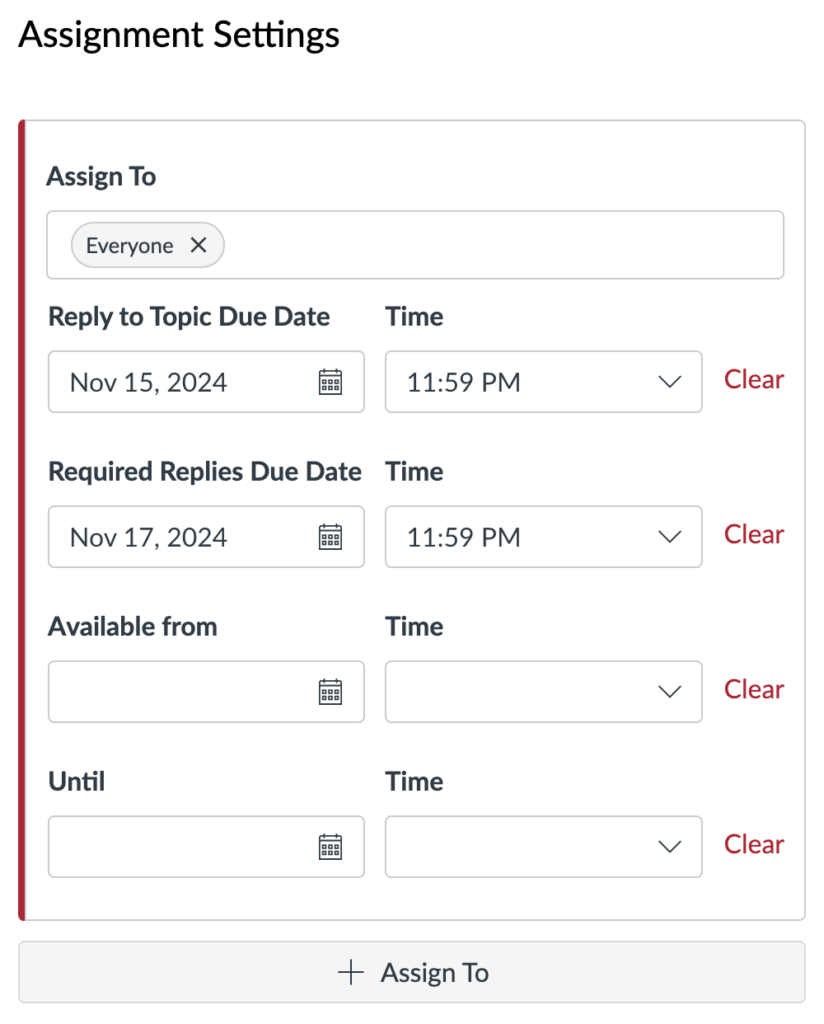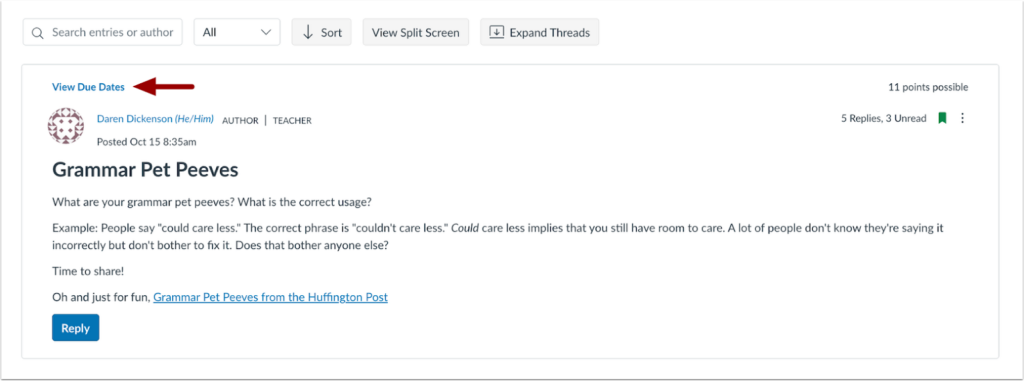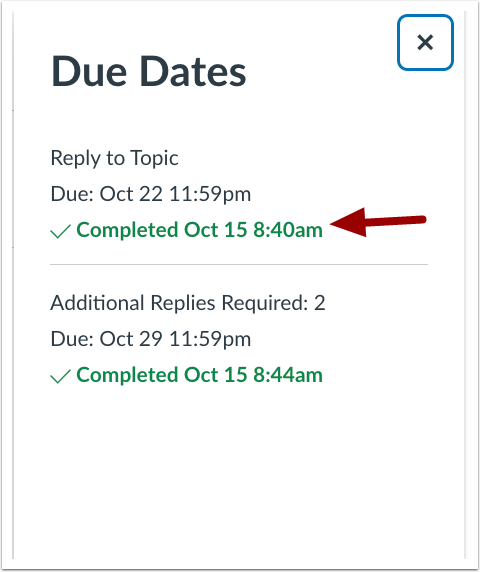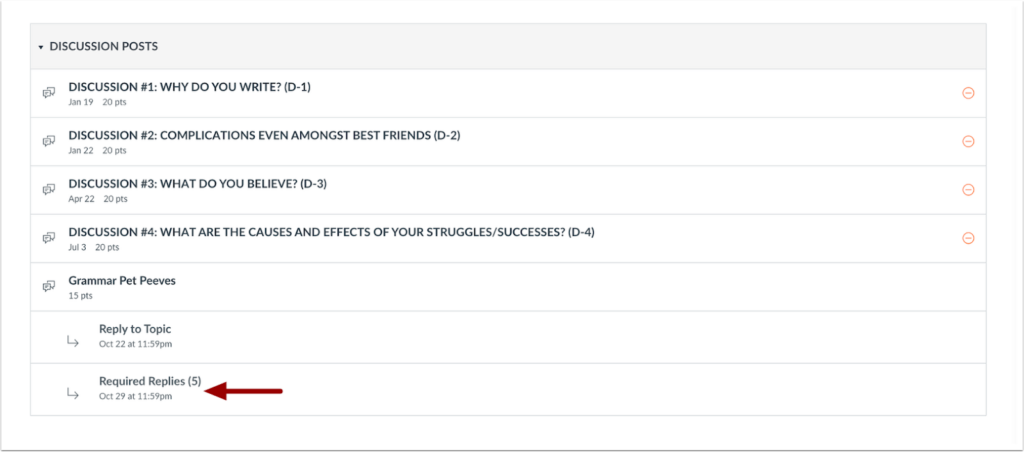Update (November 19, 2024): Canvas has changed the timeline for Discussion Checkpoints. It will now be available beginning January 18, 2025.
Learn how to use the new Discussion Checkpoints feature in Canvas to assign an initial post and required replies.
When assigning discussion boards on Canvas, it’s common for faculty to assign an initial post and one or more required replies, often with several days in between them. Previously, you had to assign and score those discussions as one item with one due date, making it harder for students to intuitively identify what they needed to do and when.
As of January 18, 2025, faculty can now configure Discussion Checkpoints in Canvas, a feature that splits the scoring and due dates of discussions into two separate items: the initial post (called “Reply to Topic”) and required replies.
For a quick overview, watch this explainer video from Instructure:
How to Set Up Discussion Checkpoints in Canvas
To enable Discussion Checkpoints, first create a new discussion or edit an existing one. In the discussion settings, ensure “Graded” is checked [1], then check the “Assign graded checkpoints” box [2]. At this point, checkpoints cannot be used in ungraded discussions.
![1 - Graded [checked], 2 - Assign graded checkpoints [unchecked]](https://bsu-wpe-blogs.s3.amazonaws.com/wp-content/uploads/sites/34/2024/11/12102705/HeatherAhern_0-1729689443348-1024x523.png)
This will add an area where you can assign points to the initial post (“Reply to Topic”) [1], the number of required replies (up to ten) [2], and points to the additional replies [3]. The point values for “Reply to Topic” and “Additional Replies” are automatically totaled [4].
![Checkpoint Settings, Points Possible: Reply to Topic [1], Additional Replies Required [2], Points Possible: Additional Replies [3], Total Points Possible [4]](https://bsu-wpe-blogs.s3.amazonaws.com/wp-content/uploads/sites/34/2024/11/12102743/HeatherAhern_1-1729689443358-1024x292.png)
Note that you must include points in [1] and [3], even if you are using Complete/Incomplete grading. In that case, I recommend assigning 0 points to both. When you grade the discussion, it will only be considered Complete if both scores are Complete, no matter the point values you configured here.
Finally, you can add due dates below for the initial post and required replies. The “Assign To” section works as usual, meaning you can have different due dates for different students or sections.

How to Grade Canvas Discussions with Checkpoints
When you grade a discussion with checkpoints, you can enter a grade and/or status for each component: initial post and required replies.
![SpeedGrader with Discussion post [1], Previous Reply and Next Reply [2], Reply to Topic Grade [3], Required Replies Grade [4], and Status dropdown [5]](https://bsu-wpe-blogs.s3.amazonaws.com/wp-content/uploads/sites/34/2024/11/12102855/HeatherAhern_7-1729689443388-1024x660.png)
The points for initial post and required replies are then totaled automatically. You still only have one comments box, and the discussion will only show as one column in the Canvas Gradebook.
Additionally, you may choose to use a rubric on a discussion with checkpoints. If you do, you will still have to manually enter the point values for each part of the discussion, as these do not currently auto-populate from the rubric scores.
How Students Interact with Discussion Checkpoints
For students, discussions with checkpoints are very similar to regular discussions. On the discussion, they will see a new button labeled “View Due Dates.”

When they click that button, a sidebar will open with the requirements and due dates. Once they have completed the appropriate components, this sidebar will display a “Completed” message with the date and time of their posts.

Discussions with checkpoints will display for students with two calendar events (one for initial post and one for required replies) and will display as two items on their to-do list. This provides a significant amount of clarity and helps remind students of what they need to do and when.
Discussions with checkpoints will also show as two items in the Modules area of your course.

Conclusion
If you require your students to reply to each other’s posts in discussions, I strongly encourage you to test out the new Discussion Checkpoints feature in Canvas. This feature helps clarify due dates and grading for students, allowing you to clearly communicate quantity and due dates of replies.
Are you planning to test out Discussion Checkpoints? Let us know your thoughts in the comments below.



Comments:
Hello! I am an Assistant Professor and had today marked on my calendar, as a hopeful for getting discussions to have different deadlines for the initial and reply postings. Unfortunately, this option is still not showing in Canvas for me. Do you have any ideas or suggestions as to why this might be?
One problem I’m having with graded checkpoints is that if I click “Assign graded checkpoints,” it will not allow me to keep “This is a group discussion” checked. Kind of frustrating that it will not allow me to use both.
Hi Molly, apologies for the delay – we got it published a few days after we initially planned. It should be live for you!
Hi Tasneem, I’m sorry it doesn’t work with group discussions. This is on Canvas’s radar, and we’re hoping that they address it in an upcoming release!
I’m still not seeing the option to Assign Graded Checkpoints!
I really hate the new discussion board layout. It is not possible to sort by date any more. You can choose oldest to newest, but it only sorts oldest new post that way, not replies to a new post, so the discussion thread has changed every time I look at it. It is really frustrating…